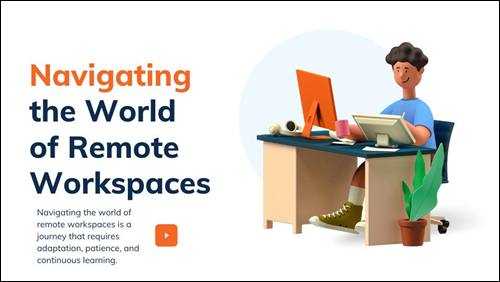
In the rapidly evolving landscape of modern work, the rise of remote workspaces has been both a revolution and a challenge. As businesses and employees adapt to this new paradigm, understanding the strategies to maximize its benefits and overcoming the inherent challenges becomes paramount.
Table of Contents
The New Reality: Remote Workspaces
The transition to remote workspaces gained unprecedented momentum due to global events, most notably the COVID-19 pandemic. This significant shift has ushered in a novel paradigm, one where the traditional boundaries between home and office are increasingly indistinct. In this new era, the concept of a fixed workplace has evolved, giving rise to diverse work settings that blend personal and professional spaces.
Presently, a considerable segment of the workforce has embraced remote work, adopting either a full-time remote setup or a hybrid model that combines remote work with occasional office attendance. This change reflects a broader transformation in work culture, highlighting a growing preference for flexibility, and the ability to balance professional responsibilities with personal life more harmoniously. As businesses and employees navigate this altered landscape, remote work has become a staple, reshaping expectations and approaches to productivity and collaboration.
Strategies for Effective Remote Work
- Structured Schedules and Boundaries: One of the key strategies for thriving in a remote workspace is establishing a structured schedule. This includes setting clear working hours and breaks, helping employees to maintain a healthy work-life balance.
- Technological Infrastructure: Ensuring robust technological infrastructure is crucial. This includes reliable internet connectivity, appropriate software tools for collaboration, and cybersecurity measures to protect sensitive data. Having a virtual office at sites like Yourcityoffice.com can provide the address and professional appearance without the need for a brick-and-mortar building.
- Regular Communication and Collaboration: Regular check-ins and meetings are essential for maintaining team cohesion and ensuring that everyone is aligned with their goals. Tools like video conferencing, chat applications, and collaborative online platforms play a vital role here.
- Creating a Conducive Work Environment: Employees should be encouraged to create a workspace that’s conducive to productivity, which includes a comfortable working area, adequate lighting, and minimal distractions.
Challenges in Remote Workspaces
While remote workspaces offer numerous benefits, they also come with challenges that need to be addressed:
- Isolation and Lack of Social Interaction: Working remotely can sometimes result in a sense of isolation due to the lack of social engagement typically found in conventional office environments. To mitigate this, organizations can foster a sense of community by organizing virtual social gatherings and promoting casual online meet-ups. These initiatives help maintain interpersonal connections and team cohesion, despite the physical distance.
- Overworking and Burnout: The absence of a physical separation between work and personal life often leads to people overworking. Companies need to emphasize the importance of unplugging after work hours to prevent burnout.
- Communication Barriers: Remote work can sometimes lead to miscommunications or a lack of clarity. This can be mitigated through clear and consistent communication channels and regular feedback sessions.
- Diverse Time Zones and Cultures: For global teams, working across different time zones and cultural differences can be a challenge. Respect for diverse work hours and cultural sensitivities is key to managing this.
Conclusion
Navigating the world of remote workspaces is a journey that requires adaptation, patience, and continuous learning. By implementing effective strategies and addressing the challenges head-on, organizations and employees can harness the full potential of remote work. The future of work is here, and it’s more flexible, digital, and connected than ever before.
Leave a Reply
You must be logged in to post a comment.